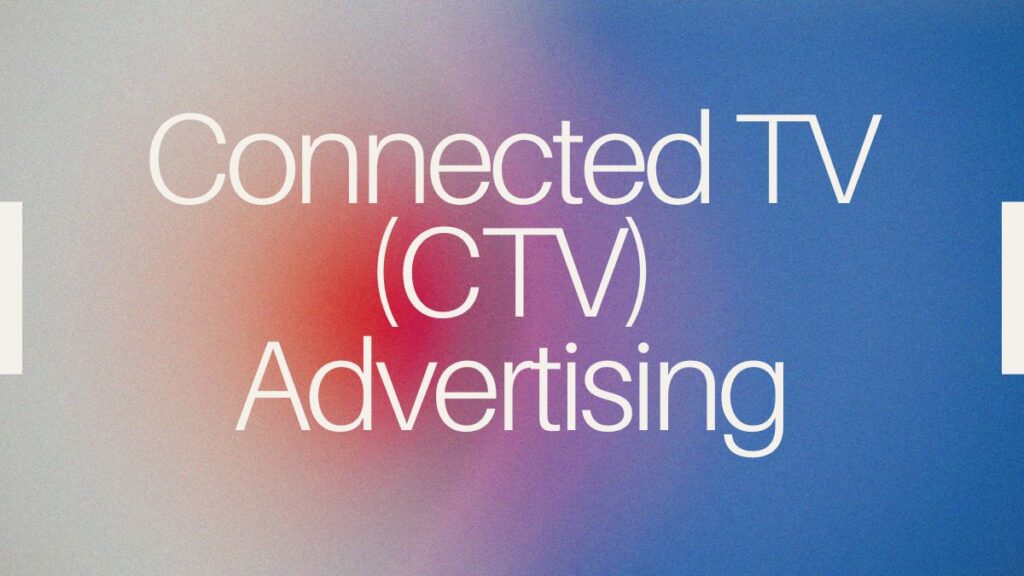
Connected TV (CTV) Advertising
Think about the last time you sat through a commercial break on cable TV. If you can’t remember, you’re not alone. Viewers today aren’t waiting for ads—they’re choosing on-demand streaming over traditional television. Platforms like Netflix, Hulu, Disney+, and YouTube TV have changed how people consume content, shifting control from networks to consumers.
This shift isn’t just a trend for advertisers—it’s a fundamental change in how audiences engage with brands. Connected TV (CTV) advertising gives businesses a data-driven, targeted, cost-effective way to reach highly engaged viewers. Unlike traditional TV ads that rely on broad audience estimates, CTV ads use real-time data to ensure brands speak to the right people at the right time.
But how does CTV advertising work, and how can brands take full advantage of it? Let’s break it down.
What is CTV Advertising and Why Does It Matter?
Connected TV (CTV) advertising refers to ads delivered through internet-connected television platforms, including smart TVs, streaming devices (Roku, Apple TV, Amazon Fire Stick), and gaming consoles. These ads play within streaming content, much like traditional TV commercials, but with one significant difference—precision targeting.
Instead of spending millions on ads that may or may not reach the right audience, CTV allows brands to:
- Use audience data to target viewers based on demographics, interests, and behavior.
- Track engagement metrics in real-time, just like digital ads.
- Retarget viewers who have previously interacted with their brand on other devices.
As more consumers move away from traditional TV, brands that embrace CTV advertising now will have a clear advantage in the evolving media landscape.
The Growth of Streaming and Why Brands Can’t Ignore It

The numbers prove just how dominant streaming has become:
- Over 90% of U.S. households have at least one internet-connected TV device.
- More than 70% of TV viewing time is spent on streaming platforms.
- CTV ad spend is projected to surpass $40 billion by 2025—doubling from just a few years ago.
Traditional cable is in decline, and advertisers who rely on outdated TV strategies are losing visibility. CTV offers something cable never could—the ability to reach a specific, engaged audience in a way that feels personal rather than disruptive.
Why CTV Advertising is More Effective Than Traditional TV Ads
1. Precision Targeting That Delivers Real Results
Traditional TV ads rely on broad audience assumptions, hoping that the right viewers happen to be watching. CTV removes the guesswork. Brands can serve ads based on:
- Age, location, and household income
- Viewing habits and content preferences
- Past online behavior and purchase history
Example: A fitness brand can target users who recently streamed workout videos, ensuring their ad reaches an audience already interested in health and wellness.
2. Higher Engagement with Unskippable Ads
Unlike YouTube or social media ads, where skipping is an option, many CTV ads are unskippable. This ensures full viewership and higher engagement rates compared to traditional digital ads.
Even more importantly, streaming audiences are already deeply engaged in long-form content. When ads align with their interests, they feel less intrusive and more relevant.
3. Seamless Multi-Device Integration
Streaming isn’t just happening on TVs—viewers watch content on their phone, tablet, or laptop. CTV advertising allows brands to create multi-touchpoint ad experiences, where a message follows the viewer across devices.
Example: A user watching a travel documentary on their smart TV sees an ad for a tropical vacation package. The next day, a follow-up ad appears on their phone, offering an exclusive discount for booking.
4. More Cost-Effective Than Traditional TV
Traditional TV ads require massive budgets and are locked into fixed time slots. CTV, on the other hand, offers:
- Better ROI by reaching a defined audience instead of mass broadcasting.
- Flexible pricing models (pay-per-impression, pay-per-click).
- Campaign tracking to see exactly how ads are performing.
Best Strategies for Successful CTV Advertising
To maximize CTV advertising, brands need to think beyond just placing ads—creating engaging, relevant, and interactive content.
1. Focus on High-Quality, Engaging Video Ads
Streaming audiences expect high-quality content, and ads are no exception. A generic commercial won’t cut it.
- Keep it short and impactful—15 to 30 seconds is ideal.
- Use cinematic visuals and high-quality sound to match the premium content viewers watch.
- Make it feel like content, not an interruption—authentic storytelling wins.
Example: Instead of a basic car commercial, a brand could produce a mini-documentary about a road trip, seamlessly integrating their vehicle into the story.
2. Personalization is Key
People engage with ads that feel tailored to them. Leverage user data to create highly relevant messaging.
- Serve different ads based on device type (mobile vs. smart TV).
- Adjust messaging based on past viewing habits.
- Retarget users who have previously interacted with your brand.

3. Experiment with Interactive Ads
Interactive elements turn passive viewers into active participants.
- Shoppable ads allow viewers to purchase directly from their screen.
- Voice-controlled ads let users engage hands-free.
- Choose-your-own-adventure ads allow users to select the ad experience they want.
4. Test, Optimize, and Refine
One of CTV’s most significant advantages is that it’s trackable. Unlike traditional TV, where results are vague, CTV provides:
- Ad completion rates
- Click-through rates
- Multi-device conversion tracking
A/B testing different ad creatives, formats, and targeting strategies will help brands refine their approach for maximum impact.
What’s Next for CTV Advertising?
CTV advertising is evolving, and the next few years will bring even more innovation.
- AI-Driven Ad Targeting – Smarter algorithms will analyze real-time behavior to serve ads with pinpoint accuracy.
- Programmatic CTV Ads – Automated, real-time ad placements will make CTV advertising as accessible as Google or Facebook Ads.
- More Interactive & Shoppable Ads – Expect ads that let viewers purchase products instantly with a remote click or voice command.
- Augmented Reality (AR) Integration – Soon, brands will use AR to let viewers virtually try on clothes, preview furniture in their home, or test out makeup shades—all from their TV screen.
The brands that embrace these trends will dominate the future of streaming media marketing.

CTV Advertising is the Future of Digital Marketing
How people watch TV has changed, and advertising strategies need to change with it.
CTV isn’t just another marketing channel—it’s the future of highly targeted, high-impact advertising. Brands that invest in CTV today will reach engaged audiences, outperform competitors, and see more substantial returns on their ad spend.
Digital Results would be happy to help you with your digital marketing needs. Get in touch for a free 30-minute consultation—one of our experts will walk through how we can help optimize your search engine optimization (SEO).
Ready to Grow Your Search Engine Results?
Let Digital Results assist you in your SEO strategy and help
deliver the search engine results you need.





